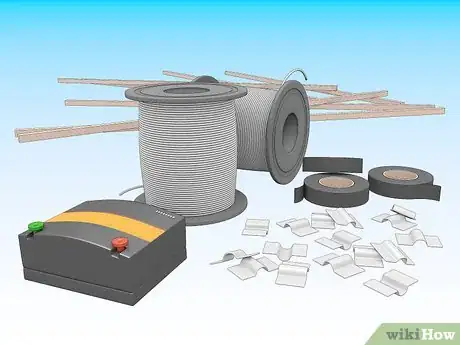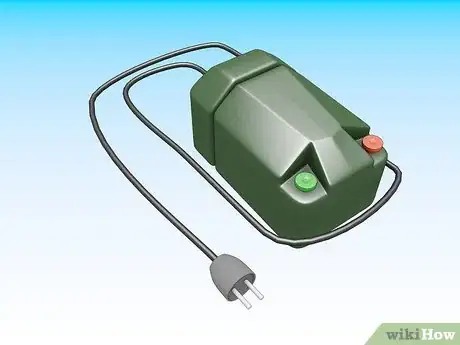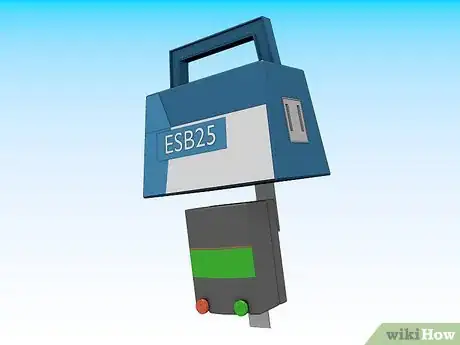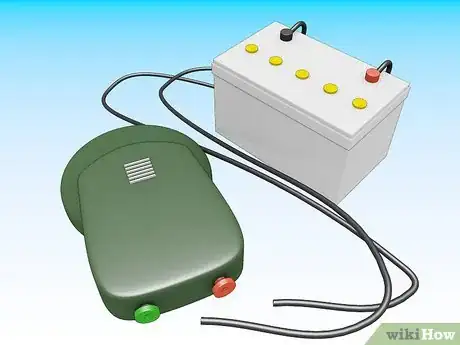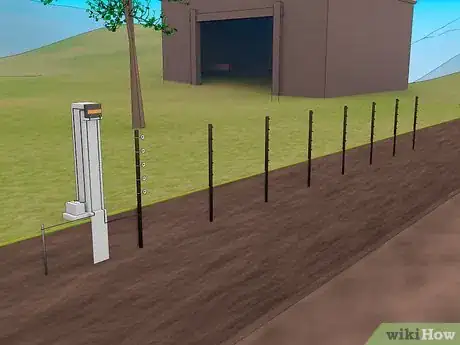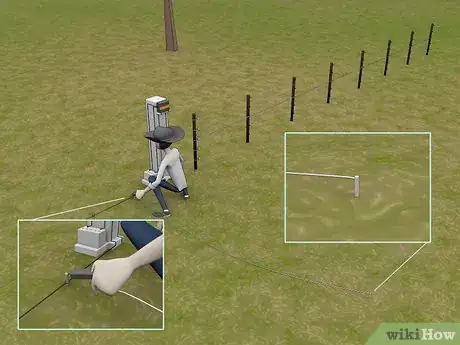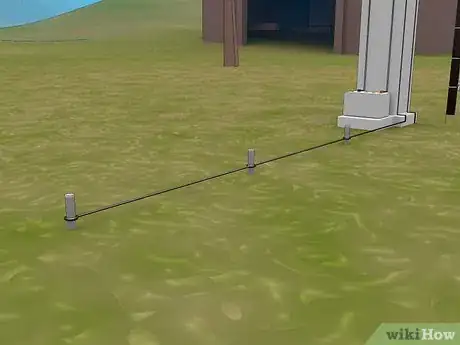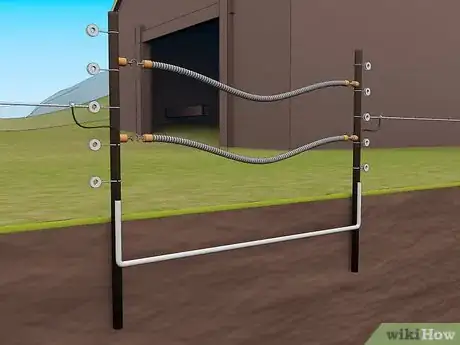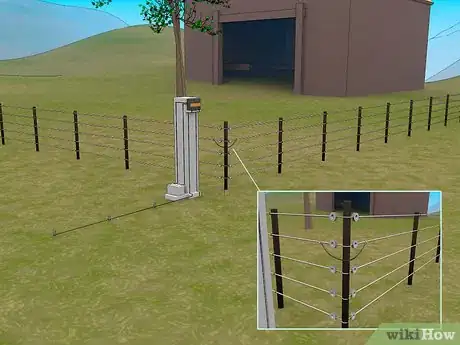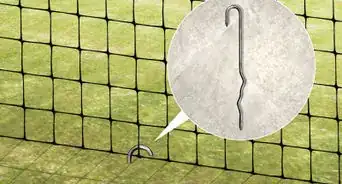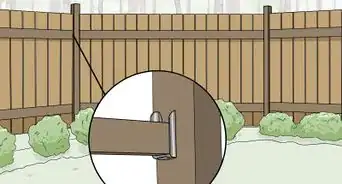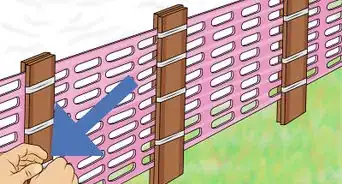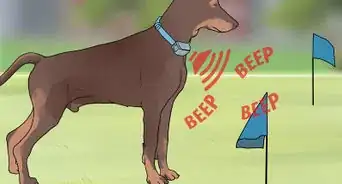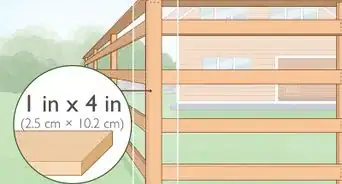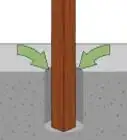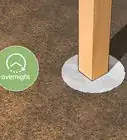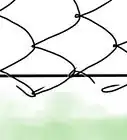X
wikiHow is a “wiki,” similar to Wikipedia, which means that many of our articles are co-written by multiple authors. To create this article, 18 people, some anonymous, worked to edit and improve it over time.
This article has been viewed 264,020 times.
Learn more...
Electric fencing can be dangerous but are a helpful tool for people who own farm livestock or horses, or who need added security. Electric fencing are necessary in order to keep animals safe and contained within the fence, as well as to keep intruders out. When you learn how to make an electric fence properly, you must be extra cautious so you don't electrocute yourself.
Steps
-
1Figure out what type of electric fence you will need.
- If you need a portable fence, purchase lightweight equipment such as polywire and tape, plastic posts, battery-powered energizers, and reels. If you need a permanent fence, purchase high-quality insulators, self-insulating electro-wood, or wooden posts. High-tensile wire should be used to fence livestock while electro-rope and tape work well for horses.[1]
-
2Determine the type of animal you want to fence. Horses are best fenced with conductors that are highly visible, such as rope and tape. Slower-moving animals, such as cattle and sheep, can be fenced with steel wire or polywire. Regardless of the animals you are containing, the structure needs to be strong and stable because nocturnal, feral animals and other wildlife will fail to see the wires and run into the fence. If the fence is not strong, these frequent hits will knock the fence down.[2]Advertisement
-
3Choose the appropriate energizer. The type of energizer you choose depends upon the fence's length, the amount of vegetation that may grow on the conductors, the type of fencing material, the type of animals, and whether or not a 230-volt power source is readily available.
- Use a mains-powered energizer whenever possible. This type of energizer is located inside a building and does not use batteries. The cost to operate a mains-powered energizer is low.
- Use a dry battery-powered energizer if your electric fence is moved on a daily or frequent basis. You will need an internal battery, such as an ESB25 or ESB115. Dry battery-powered energizers are easy to relocate and require no maintenance. Although these type of energizers are not rechargeable, they usually last 4 to 6 months before they need to be replaced.
- Use a wet battery-powered energizer if your electric fence will be permanent or moved infrequently. More specifically, a12v energizer with a 12v 80 ampere-hour (Ah) leisure battery will work. Wet battery-powered energizers are more powerful than the dry type and can operate longer electric fences.
-
4Plan the location of the earth terminal. For the electric fence to work correctly, it needs to have optimal conditions for its operation. For example, electric current flows better in wet conditions than in dry conditions. Regardless of the battery system you are using, use at least a 3.3-foot (1 m) galvanized earth stake should be used. If you are using a mains energizer and must operate on poor soil conditions such as light or sandy soil, more than 1 earth stake could be necessary. If additional stakes are used, space them 9.8 feet (3.0 m). (3 m) apart, and connect them with a lead-out cable.[3]
-
5Test your fence. For temporary or portable fencing, use a fence line tester. For permanent fencing, use an LED voltmeter. To operate either type of tester, push the probe into the ground, and touch the tester terminal to the fence. Be sure to test at the furthest end from the energizer to get an accurate measurement of the voltage. The fence should have a minimum of 3000 volts. If it is lower, the livestock will not get sufficient shock and will cause problems.[4]
-
6Test the earth. Use a metal bar or earth stake at least 328 feet (100.0 m). (100 m) from the stakes, and short the electric fence to earth. One probe of the voltmeter must be connected to a stake. The other probe should be pushed into the ground as far away from the stake as possible. If the reading is 400 or 500 volts, the fence is fine. If it reads less than 400 or 500 volts, the condition of the earth needs to improve.[5]
-
7Add additional earth stakes 3.3 feet (1.0 m). (1 m) apart. Connect the top of each stake with lead out cable. Re-check the voltage. Remove the short from the fence by removing the metal bar or stake.
-
8Build an electric fence gates. Transfer power under the gate from 1 side to the other with an under-gate cable. Permanent and temporary gates should be wired identically.[6]
-
9Install fence lines. Connect your high tensile wire or electro-rope and tape with insulators, depending on which type of animal you are fencing in. Your wire or electro-rope will come with instructions on how to properly space it.
Advertisement
Community Q&A
-
QuestionHow can I connect a battery and cables to make a hot fence?
 Community AnswerConnect the battery to a fence charger/energizer first. After this is done, connect the positive side of the fence charger output to the fence, and the - negative terminal to a grounding system. Grounding systems could be a steel rod system pounded into the ground, using an existing water culvert, etc. The more surface area exposed to the ground, the lower the resistance, and the better a fence ground.
Community AnswerConnect the battery to a fence charger/energizer first. After this is done, connect the positive side of the fence charger output to the fence, and the - negative terminal to a grounding system. Grounding systems could be a steel rod system pounded into the ground, using an existing water culvert, etc. The more surface area exposed to the ground, the lower the resistance, and the better a fence ground. -
QuestionHow long should the space between the stakes be?
 Community Answer3 meters is the proper length.
Community Answer3 meters is the proper length. -
QuestionDoes the fence wire need to be a completed circuit?
 KarinTop AnswererYes. The fence will not work if the circuit is incomplete or shorted out. That's where grounding rods, making sure plants don't grow up and touch the fence, and proper connections are important. It's not just the fencing wire that counts, but the other things that come with it.
KarinTop AnswererYes. The fence will not work if the circuit is incomplete or shorted out. That's where grounding rods, making sure plants don't grow up and touch the fence, and proper connections are important. It's not just the fencing wire that counts, but the other things that come with it.
Advertisement
Warnings
- Never connect electric fence energizers to electricity board earth, water pipes, or building stanchions.⧼thumbs_response⧽
- Use extreme caution with high voltage.⧼thumbs_response⧽
Advertisement
Things You'll Need
- Posts (wooden or plastic)
- Wiring (polywire and tape, high-tensile wire, or electro-rope and tape)
- Insulators
- Reels
- Energizer
- Voltage tester
- Metal bar or stake
- Galvanized earth stakes
References
- ↑ https://www.tractorsupply.com/know-how_farm-ranch_fencing_how-to-select-an-electric-fence
- ↑ https://www.tractorsupply.com/know-how_farm-ranch_fencing_how-to-select-an-electric-fence
- ↑ https://www.stafix.com/en/helpful-information/earthing-your-energizer
- ↑ https://www.youtube.com/watch?v=44MXSn25Xhs
- ↑ https://www.youtube.com/watch?v=44MXSn25Xhs
- ↑ https://www.youtube.com/watch?v=zg8xn2yBmTw
About This Article
Advertisement

